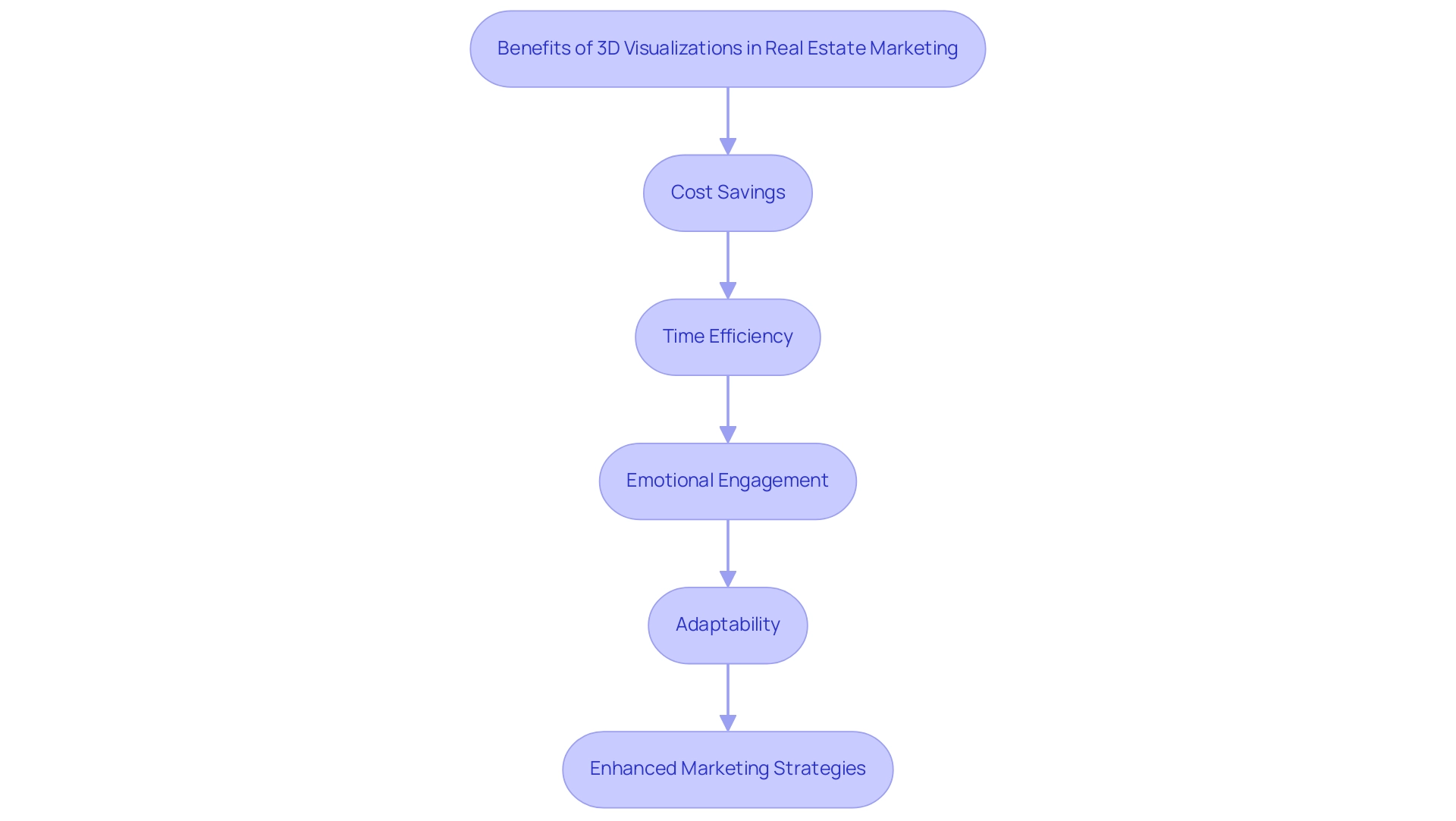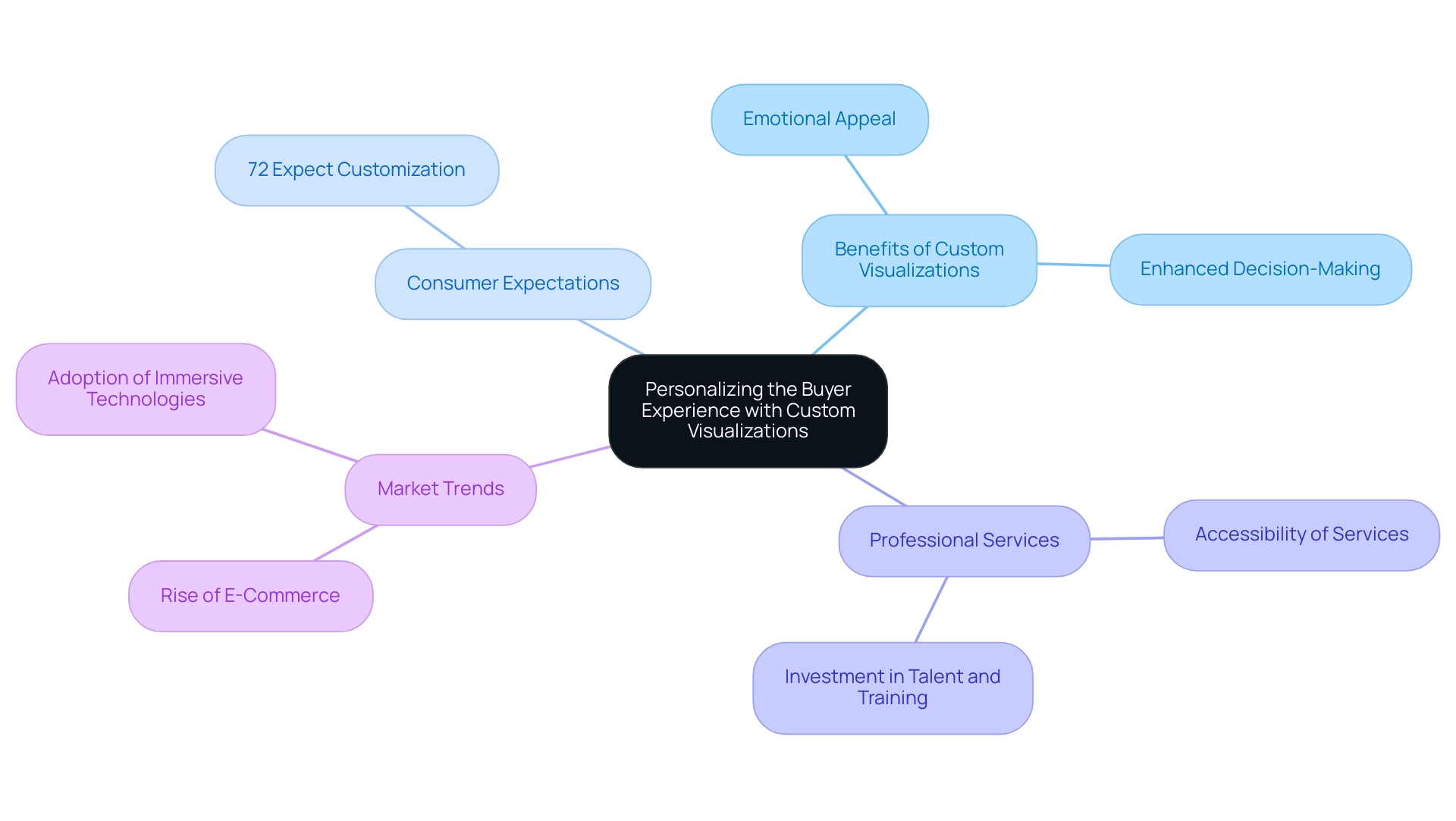Overview:
The article outlines seven key benefits of 3D visualizations in real estate marketing, emphasizing their ability to enhance property presentations, boost engagement, and personalize buyer experiences. These benefits are supported by evidence showing that 3D renderings create immersive, emotionally engaging experiences that facilitate informed decision-making, improve marketing efficiency, and ultimately lead to higher conversion rates in a competitive market.
Introduction
In an era where visual communication dominates the real estate landscape, the integration of 3D visualizations has emerged as a transformative force in property marketing. These advanced renderings not only provide potential buyers with immersive experiences but also facilitate a deeper emotional connection to properties, setting the stage for informed decision-making. As the industry evolves, leveraging high-quality 3D visualizations becomes essential for real estate professionals seeking to enhance engagement, streamline marketing strategies, and gain a competitive edge.
This article delves into the multifaceted benefits of 3D visualizations, exploring their role in:
- Enhancing property presentations
- Boosting buyer interest through interactivity
- Achieving cost efficiency
- Personalizing the buyer experience
By examining these critical aspects, the article underscores the pivotal role of visual storytelling in shaping the future of real estate marketing.
Enhancing Property Presentations with 3D Visualizations
The benefits of the role of 3D visualizations in real estate marketing are evident in their ability to enhance presentations by delivering realistic and immersive depictions of architectural designs. These high-quality renderings enable potential clients to engage with spaces, materials, and design elements in ways that traditional photography simply cannot achieve. For instance, when showcasing a luxury home, intricate details such as dynamic lighting effects, rich textures, and precise spatial relationships can be illustrated, weaving a compelling narrative that captivates the viewer.
This improved visual storytelling not only attracts attention but also highlights the benefits of the role of 3D visualizations in real estate marketing, enabling consumers to make informed choices by gaining a clearer understanding of the space’s flow and layout. Statistics indicate that the benefits of the role of 3D visualizations in real estate marketing significantly enhance buyer engagement by enabling clients to connect with properties on an emotional level. Moreover, determining the appropriate level of detail in these architectural renderings is crucial, as it helps both homeowners and businesses visualize their projects effectively.
The studio offers crucial assistance for producing high-quality 3D renders for property and architectural projects, ensuring that these representations meet industry standards. As highlighted in the case study titled ‘The Power of Pre-Sales Visualization,’ the benefits of the role of 3D visualizations in real estate marketing include serving as a bridge between concept and reality, which enhances project confidence and generates investment long before physical construction begins. This process not only enhances investor interest but also produces vital income for construction, showcasing the benefits of the role of 3D visualizations in real estate marketing by enabling effective communication and emotional engagement.
Furthermore, the immersive impact of these representations fosters community connections, allowing future homeowners to envision their place within a vibrant neighborhood. As noted by Malgo Widaj, founder of RNDR:
Now RNDR teams are helping product designers, architects, and developers around the globe to increase visual communication through storytelling images…
Boosting Engagement and Interest Through Interactive Visuals
Interactive 3D visualizations are revolutionizing the way potential buyers engage with properties, allowing them to explore spaces at their own pace. Features such as hassle-free self-guided tours and 360-degree views enable users to navigate through listings, zoom in on intricate details, and customize elements like wall colors or furniture arrangements. These self-directed tours greatly decrease the time clients spend traveling to various listings, enabling Realtors to enhance their sales efficiency with reduced effort.
This heightened level of interactivity not only extends the time users spend on property listings but also cultivates a profound emotional connection with the spaces they are considering. Statistics suggest that visual content is 43% more convincing than text by itself, and with an average TikTok engagement rate of 3.5%, it’s clear that as consumers become more engaged in their virtual exploration, their chances of cultivating a genuine interest in making a purchase rise. Additionally, testimonials from satisfied clients at J. Scott Smith Visual Designs, such as ‘The virtual tour made it so easy to find our dream home without the hassle of endless viewings,’ highlight the trust and reliability that foster lasting partnerships, underscoring the importance of client feedback in achieving exceptional results.
This makes the incorporation of interactive 3D representations a vital approach in modern estate promotion, highlighting the benefits of the role of 3D visualizations in real estate marketing, especially as 88% of marketers are increasing their investments in interactive content to drive engagement and conversion rates. Moreover, with 43% of consumers preferring interactive content, the benefits of the role of 3D visualizations in real estate marketing include:
– Enhancing client understanding
– Improving stakeholder communication
– Identifying design issues early
These factors solidify their place in the competitive landscape of 2024 and beyond.
Achieving Cost and Time Efficiency in Marketing Strategies
The incorporation of high-quality 3D visualizations in property promotion showcases the benefits of the role of 3D visualizations in real estate marketing, as it not only provides significant cost and time savings compared to conventional methods but also enhances the emotional bond potential purchasers feel with homes. While conventional staging practices involve significant expenses for physical setups, photography, and multiple revisions, 3D renderings allow for rapid, cost-effective modifications based on client feedback, ensuring accuracy and client satisfaction. This adaptability is crucial, enabling real estate professionals to refine their marketing strategies without incurring additional costs.
Furthermore, detailed and intricate renderings bring every element to life, capturing the way sunlight dances off surfaces and highlighting the subtle texture of materials, which enriches the visual appeal and emotional resonance of listings. Interactive 3D representations highlight the benefits of the role of 3D visualizations in real estate marketing by attracting potential buyers through the showcasing of the listings’ potential, particularly with virtual staging and redesigning using VR and AR technologies. These approaches not only demonstrate the possibilities of vacant spaces but also enhance perceived value, leading to higher conversions and improved key performance indicators (KPIs).
The meticulous detail and accuracy ensured by the use of advanced software highlight the benefits of the role of 3D visualizations in real estate marketing, further solidifying their impact on showcasing and sales. As CG Viz Studio highlights, with the ongoing progress of technology, the benefits of the role of 3D visualizations in real estate marketing are poised to become even more crucial.
Gaining a Competitive Edge in Real Estate Marketing
In the fiercely competitive landscape of property, the benefits of the role of 3D visualizations in real estate marketing provide a significant advantage by enabling assets to distinguish themselves from the competition. Stunning visual content demonstrates the benefits of the role of 3D visualizations in real estate marketing by not only capturing the attention of potential buyers but also enhancing their engagement compared to standard photography. Properties that highlight the benefits of the role of 3D visualizations in real estate marketing, including immersive 3D walkthroughs and high-quality renderings, tend to generate a higher volume of inquiries and viewings.
This is particularly important as intricate details—such as the way sunlight dances off windows or the texture of bricks—bring projects to life, making them feel authentic and lived-in. For instance, a case study reveals the benefits of the role of 3D visualizations in real estate marketing, as they facilitate showcasing properties to a broader audience, effectively expanding reach beyond those able to attend physical showings. This strategy has proven crucial for real estate agents aiming to establish their brand and secure listings in a market where first impressions are of utmost importance.
Significantly, Bella Staging has attained a customer rating of 4.9 out of 5 based on 313 reviews, which highlights the benefits of the role of 3D visualizations in real estate marketing for enhancing client satisfaction. As stated by J. Scott Smith Visual Designs, the experience and feedback from clients are cornerstones of their commitment to excellence, reflecting trust and shared vision. One client remarked, ‘The 3D renderings made my home feel alive, and I received multiple offers within days of listing!’
As technology continues to advance, the benefits of the role of 3D visualizations in real estate marketing are set to become even more pivotal, shaping the future of how properties are showcased and sold. Leveraging these high-quality visual renderings highlights the benefits of the role of 3D visualizations in real estate marketing, enhancing marketing effectiveness and positioning agents competitively within the market. The emotional connection fostered by these intricate details can significantly influence customers’ perceptions, making them more likely to envision themselves in the space.
Personalizing the Buyer Experience with Custom Visualizations
The incorporation of customized 3D representations in architectural design greatly improves the customer experience by aligning with personal preferences and lifestyles. By allowing potential buyers to explore various design options—such as floor plans, color schemes, and furnishings—these visualizations empower them to envision their future home tangibly. This level of customization not only amplifies the emotional appeal of a property but also fosters a deeper investment in the decision-making process.
Our team of experts creates custom 3D models tailored to specific needs, ensuring seamless integration with marketing strategies and providing a realistic and engaging customer experience. Moreover, the accuracy of our 3D renderings is crucial in ensuring that the final build aligns with your vision, helping to eliminate bad ideas and ensuring only the best concepts are realized. Current trends suggest that 72 percent of consumers anticipate companies to acknowledge their uniqueness and preferences, emphasizing the importance of personalized visual experiences in property.
Professional 3D modeling agencies now provide high-quality services at competitive rates, making these customized visualizations more accessible to property marketers. Companies are also investing in talent and training to enhance their capabilities in delivering personalized experiences, highlighting the importance of skilled professionals in this evolving landscape. In the context of the real estate sector, leveraging tailored visual options can significantly enhance buyer engagement and satisfaction, showcasing the benefits of the role of 3D visualizations in real estate marketing by ultimately driving higher conversion rates and reinforcing the value of customization in the market.
Conclusion
The integration of 3D visualizations in real estate marketing has transformed property presentations, creating immersive experiences that foster emotional connections with potential buyers. These advanced renderings showcase intricate details and spatial relationships, enabling informed decision-making that traditional methods often lack.
Interactive visuals enhance buyer engagement through self-guided tours and customizable features, allowing users to explore properties at their own pace. This interactivity significantly boosts the likelihood of genuine interest and conversions, as visual content is proven to be more persuasive than text.
Moreover, the cost and time efficiency of 3D visualizations make them an attractive option for real estate marketers. By reducing the need for physical staging and allowing rapid modifications, these tools refine marketing strategies without incurring excessive costs, ultimately improving performance metrics.
In a competitive market, distinguishing properties with stunning visual content is essential. 3D visualizations capture attention, expand outreach, and build trust through positive client feedback. Personalization further enriches the buyer experience by enabling individuals to envision their unique preferences within potential homes.
In summary, the multifaceted benefits of 3D visualizations—enhanced presentations, interactivity, cost efficiency, and personalization—highlight their vital role in the future of real estate marketing. Embracing these innovative tools is crucial for professionals seeking to elevate their strategies and drive engagement in an evolving digital landscape.






0 Comments